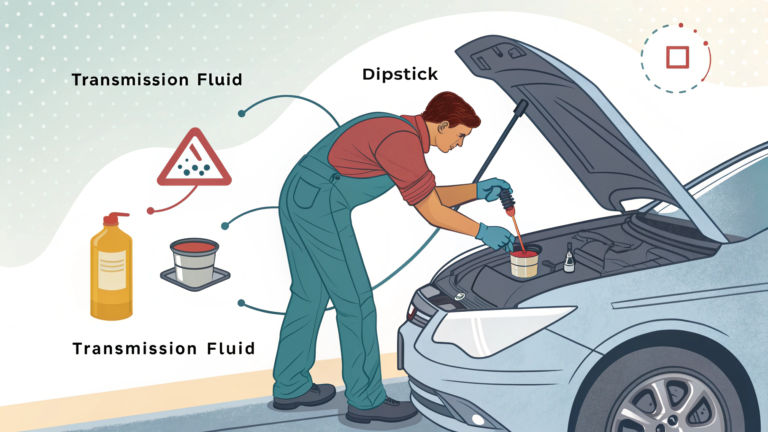
Checking transmission fluid is one of the most important steps to keep a vehicle healthy.
It helps the transmission shift smoothly, avoid damage, and last a long time. Many car owners think it is difficult, but it is actually simple when explained clearly.
This guide will show you easy steps, signs, methods, and tips to check transmission fluid the right way.
What Is Transmission Fluid?
Transmission fluid is a special oil that keeps your vehicle’s transmission system running smoothly. It lubricates the moving parts, keeps temperatures safe, and helps the transmission shift gears. Without clean and proper fluid levels, your car may start slipping, overheating, or losing power. This is why checking it regularly is an important part of basic car care.
Why Checking Transmission Fluid Matters?
Checking transmission fluid is important because it helps you catch problems early. Low or dirty transmission fluid can lead to expensive repairs. Your car might start shaking, shifting slowly, or making unusual noises if the fluid level is low. By checking it on time, you protect your transmission from damage. You also ensure that the car’s performance stays smooth.
Safety Tips Before You Start
Before checking transmission fluid, make sure the car is on a flat surface. Keep the parking brake on for safety. Some vehicles require the engine to be running and fully warmed up when checking the fluid. Always use gloves when handling fluid to avoid skin irritation. Make sure you know your vehicle’s specific instructions because different models can have different procedures.
Tools You Need
Checking transmission fluid does not require many tools. Most people only need a clean cloth or paper towel to wipe the dipstick. Some cars need a funnel if you must add more fluid. A flashlight can help you see the markings clearly. For sealed transmissions, you may need a mechanic’s tool kit, but most everyday users will check through a dipstick.
How to Check Transmission Fluid (Step-by-Step)?
The steps may change depending on your car, but most vehicles follow a simple process:
- Start the engine and let it warm up. Transmission fluid expands when warm, so this step is important.
- Keep the car in “Park” or “Neutral,” depending on what your manual recommends.
- Open the hood and find the transmission dipstick. It usually has a label or a colored handle.
- Pull out the dipstick and wipe it clean with a cloth.
- Reinsert the dipstick fully and pull it out again to check the fluid level.
- Look at the markings. The fluid should be between “Full” and “Low.”
- Check the fluid color and smell. Healthy transmission fluid is usually red or pink.
- If the fluid is dark, brown, or smells burnt, it needs to be changed.
- If the level is low, add the recommended type of fluid slowly using a funnel.
- Put the dipstick back in place and close the hood.
Understanding Transmission Fluid Colors
Transmission fluid color tells you a lot about the health of your transmission. Fresh fluid is bright red and clear. If it looks slightly darker but still red, it is normal with use. Brown fluid means the fluid is old and needs changing. If it looks black or smells burnt, there may be a serious problem. Milky fluid could mean coolant is mixing with the transmission fluid, which needs urgent repair.
How Often Should You Check Transmission Fluid?
For most vehicles, it is good to check the fluid once a month. Some drivers check more often if they travel long distances or drive in hot weather. Transmission fluid usually lasts a long time, but checking it regularly helps catch early signs of problems. Always follow your vehicle’s maintenance schedule for fluid changes.
Signs You May Have Low Transmission Fluid
Your car gives warning signs when transmission fluid is low. One common sign is hard shifting or delayed shifting. You may hear grinding noises or feel vibrations when the car changes gears. Some cars may even slip out of gear. If the car struggles to accelerate or if the engine revs but the car does not move faster, low fluid might be the cause. These signs should not be ignored.
How to Add Transmission Fluid Safely?
If you need to add transmission fluid, start by confirming the correct type for your vehicle. Add the fluid slowly using a funnel to avoid spills. Add small amounts, checking the dipstick in between to avoid overfilling. Too much fluid can cause pressure problems and damage the transmission. When finished, make sure the dipstick is securely in place.
What Happens If You Never Check Transmission Fluid?
If transmission fluid is never checked, the transmission may overheat or fail. The gears may wear out, and the car might stop moving altogether. Transmission repairs are often expensive, costing more than basic maintenance. Checking the fluid regularly saves money and prevents breakdowns.
Manual Transmission vs. Automatic Transmission Fluids
Manual transmissions sometimes use a different type of fluid than automatic ones. Many manual cars do not have a dipstick and require checking from underneath the vehicle. Automatic transmission fluid, often called ATF, is used in automatic cars and helps the system shift smoothly. Always check which type your car needs before adding fluid.
Can You Drive With Low Transmission Fluid?
Driving with low transmission fluid is unsafe for the transmission. The gears and parts inside may grind against each other due to lack of lubrication. This can cause fast wear and overheating. If you suspect low fluid, it is best to check or refill it quickly. Driving too long without enough fluid may cause complete transmission failure.
Checking Transmission Fluid in Sealed Transmissions
Some newer cars have sealed transmissions, meaning they do not come with a dipstick. This makes checking the fluid more difficult. You may need special tools and a safe way to lift the car. Because sealed transmissions are designed to last longer, they usually need less frequent service. However, if the car shows signs of transmission trouble, a professional should check it.
How Weather Affects Transmission Fluid?
Hot and cold weather can affect transmission fluid performance. In very hot weather, fluid can thin out and break down faster. In cold weather, it may thicken and shift slower until the car warms up. This is why checking fluid before long trips or extreme weather conditions is helpful. Keeping the fluid at the right level helps protect your transmission in any climate.
Common Mistakes to Avoid
Many people make simple mistakes when checking transmission fluid. One mistake is checking the fluid when the engine is cold. Another mistake is overfilling the fluid, which can cause pressure buildup. Using the wrong type of fluid can also harm your car. Mixing fluid types should always be avoided. Some people forget to secure the dipstick after checking, which can lead to leaks.
When to Get Professional Help?
If you see metal particles in the fluid or smell burning, professional help is needed immediately. Strange noises, slipping gears, or rough shifting may also mean deeper transmission problems. A trained mechanic can diagnose issues and recommend repairs. Getting help early prevents expensive damage later.
Conclusion
Checking transmission fluid is simple, helpful, and important for vehicle health. It protects the transmission, keeps the ride smooth, and saves money on repairs.
With the steps in this guide, anyone can check transmission fluid confidently at home. Taking a few minutes to inspect the fluid can prevent big problems in the future.
Regular care keeps your car reliable and safe for long journeys.
FAQs
1. How often should I check transmission fluid?
You should check it at least once a month or before long trips. Regular checking helps you catch problems early. Always follow your vehicle’s manual for exact timelines.
2. What color should transmission fluid be?
Healthy transmission fluid is bright red and clear. If it turns brown or smells burnt, it needs replacement. Black or milky fluid signals serious issues.
3. Can low transmission fluid damage my car?
Yes, low fluid can cause overheating, slipping, and gear damage. If ignored, it may lead to complete transmission failure. Always refill fluid on time.
4. How do I know if my car is low on transmission fluid?
Signs include delayed shifting, slipping gears, or strange noises. You might also notice poor acceleration. Checking the dipstick confirms the level.
5. What should I do if the fluid looks burnt?
Burnt fluid means it is old or the transmission is overheating. You should replace it as soon as possible. If the problem continues, get professional help.
6. Can I add transmission fluid myself?
Yes, most car owners can add fluid using a funnel and dipstick. Add slowly and check often to avoid overfilling. Use only the correct type of fluid.
7. Do all cars have a transmission dipstick?
No, some newer cars have sealed transmissions without a dipstick. These require professional tools to check. This design helps reduce user mistakes.
8. What type of transmission fluid does my car need?
Different cars require different fluid types. The best source is your owner’s manual. Using the wrong fluid may damage your transmission.
9. Why does transmission fluid get dirty?
Fluid gets dirty as it collects metal particles and dust from the transmission. Heat also breaks down the fluid. Dirty fluid means it is time for a change.
10. Can cold weather affect transmission fluid?
Yes, cold weather can make fluid thicker, causing slow shifting. The car may shift normally once it warms up. Keeping the fluid at the right level helps it work better.






